 Previous Page Next Page
Previous Page Next Page
Specifying multiple values for a parameter
When you preview, print or export a report with parameters, or preview a query that contains parameters, JReport Designer will prompt you the Enter Parameter Values dialog to specify values for the parameters. All the parameters used in the report or query and the prompting information are listed.
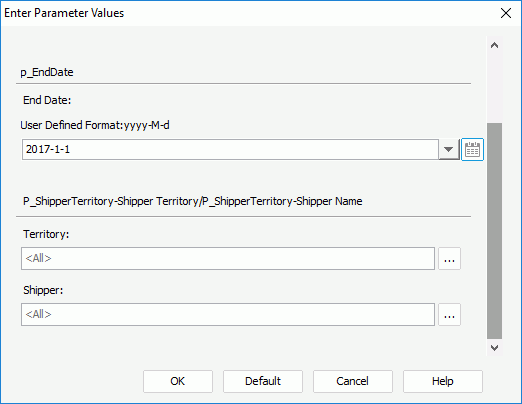
The way to specify a parameter value varies with the type and properties of the parameter. Here are several ways you can use to specify parameter values:
 to specify multiple values if the parameter allows for multiple values.
to specify multiple values if the parameter allows for multiple values. to specify a date and time value.
to specify a date and time value.Note: You are recommended not to use blank as the thousands separator in Number-typed parameter values under French locale, otherwise your input will not be correctly recognized because of a JVM bug. For details, see http://bugs.sun.com/view_bug.do;jsessionid=c8cdaf911b20fffffffffd9fc6340b30d670?bug_id=4510618.
For a parameter that allows for multiple values (the parameter's Allow Multiple Values property is true), you can specify one or more values to it.
 next to the value text box of the parameter. The Enter Values dialog appears.
next to the value text box of the parameter. The Enter Values dialog appears.
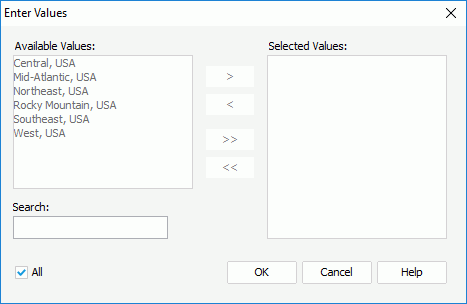
 to add them to the Selected Values box; to add all the available values, click
to add them to the Selected Values box; to add all the available values, click  . You can make use of the Search text box to
search for the required values among the available values: type in the keyword
and the available values that contain the keyword will be listed with the keyword highlighted in the values.
. You can make use of the Search text box to
search for the required values among the available values: type in the keyword
and the available values that contain the keyword will be listed with the keyword highlighted in the values.
If some added values are not wanted, select them in the Selected Values box and click  to remove them; to remove all added values, click
to remove them; to remove all added values, click  .
.
 next to add it to the Selected Values box. When the parameter is bound with a column, but the display column is different from the bound column, make sure the value you enter is that of the bound column. If the parameter is of the Date, Time or DateTime type, you can also click the calendar button
next to add it to the Selected Values box. When the parameter is bound with a column, but the display column is different from the bound column, make sure the value you enter is that of the bound column. If the parameter is of the Date, Time or DateTime type, you can also click the calendar button  to specify a date and time value.
to specify a date and time value.
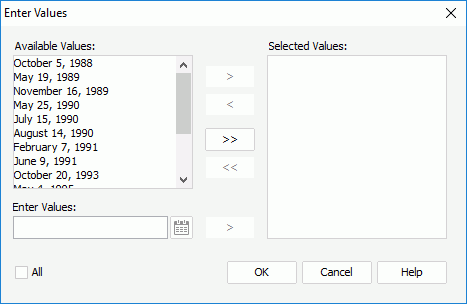
When specifying value for a parameter of the Date, Time or DateTime type which allows for type-in values (the parameter's Allow Type-in of Value property is true), you can make use of the calendar to select a date and time as the value, or customize a dynamic date and time value by creating an expression using JReport's built-in Date/Time functions. For example you might want the start date to always be 7 days ago and the end date to be today, you can then customize the value for the start date parameter as dateadd('d', -7, today()) and today() for the end date parameter. The expression has higher priority than the value specified using the calendar.
To select a date and time value from the calendar:
 next to the value text box of the parameter. The following dialog appears.
next to the value text box of the parameter. The following dialog appears.
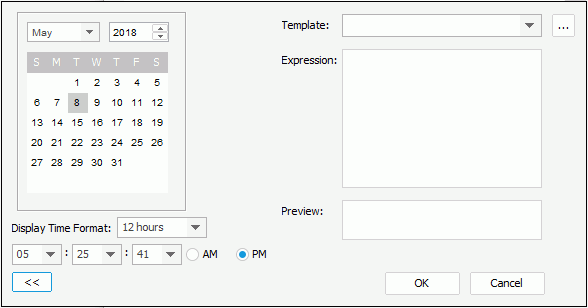
In the calendar on the left, specify the month, year and day accordingly.
If the parameter is of DateTime type, the time setting is available. From the Display Time Format drop-down list, specify in which format to display the time, 12 hours or 24 hours (each time when the calendar is accessed, the default selected format is always 12 hours), then select the hour, minute and second time from the corresponding drop-down lists and choose whether it is AM or PM.
To customize a dynamic date and time value by creating an expression:
 next to the value text box of the parameter. The following dialog appears (if the right section of the dialog is not displayed,
click
next to the value text box of the parameter. The following dialog appears (if the right section of the dialog is not displayed,
click  on the bottom left corner to expand it).
on the bottom left corner to expand it).

 next to the Template drop-down list.
next to the Template drop-down list. 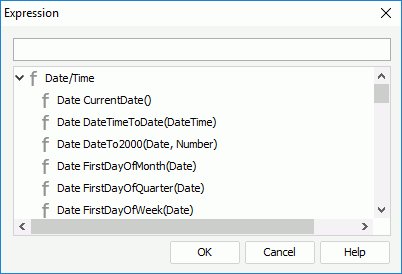
The Preview box calculates the result of the current expression. Each time you modify the expression, you can click in the box to refresh the result. The date/time in the calendar on the right can be synchronized with the date/time calculated by a valid expression. If it is an invalid expression, an error message will be shown in the box and no change will be made to the calendar and the currently selected date/time will be remained in the calendar.
After you use an expression to specify the value, when you hover the mouse pointer over this value in the Enter Parameter Values dialog, a tip will appear showing its expression. Click in the value text box, the expression will be displayed in the text box. You can edit the expression in the text box directly if you want. After editing, when you click elsewhere outside of the value text box:
By default the parameters are displayed in ascending alphabetic order in the Enter Parameter Values dialog, thus the parameter pEndDate appears before pStartDate which would be very confusing to users. JReport allows you to customize the display order of the parameters in the dialog so that they could be shown in a more reasonable sequence. The order will not affect the display sequence of the parameters in the resource tree, which is determined by the Sort setting in the Options dialog.
You can customize the parameter display order at two levels: catalog and specific report. When the order of parameters in a catalog is specified, the order will be applied to all reports using the catalog. When both levels of orders are configured, the report level order has higher priority than the catalog level one.
To adjust the parameter order for a catalog: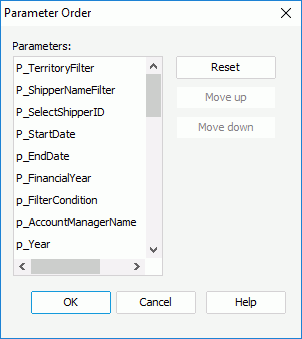
To adjust the parameter order for a specific report: